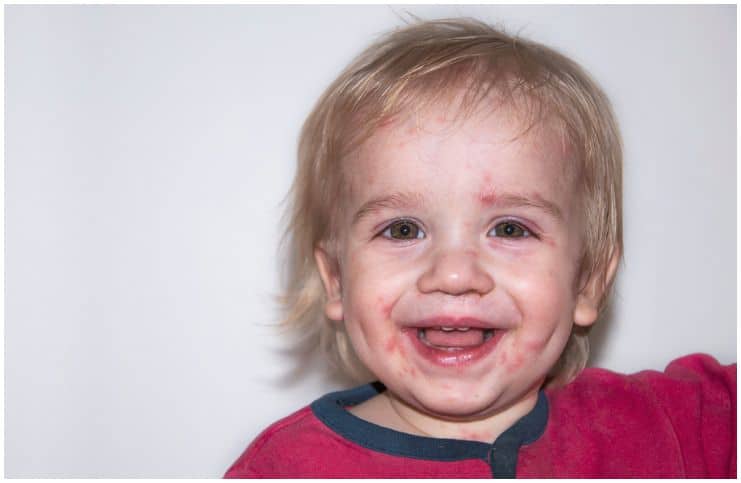This article reveals the differences between smallpox vs chickenpox:
Smallpox
Smallpox, also known as variola, is a serious, contagious, and occasionally fatal infectious disease which is caused by the variola virus.
There are records of cases of variola dating back to more than 12,000 years. The last known case of variola occurred in Somalia in 1977 and the WHO has considered the disease eradicated since 1979.
By 1984, only the CDC and the Research Institute of Viral Preparations had this virus.
Currently, renewed interest in variola is taking place, as there is some concern that the virus may be used as an agent of bioterrorism.
Variola has two forms:
- major – this form is a highly contagious viral disease with a mortality rate of about 30 percent;
- minor – it is a mild strain, that is very similar to the major form, however, it is only genetically different.
Chickenpox
Chickenpox, also known as varicella, is a viral infection that causes a rash with small, fluid-filled blisters.
Most children have this infection before the age of 10 years. It is usually much worse in adults. Spring and winter are the most common times of the year for varicella to occur.
Lifelong immunity for varicella usually follows the infection. But, the varicella-zoster virus remains inactive in the body’s nerve tissues and can return as an illness called shingles.
Symptoms
Smallpox
Symptoms commonly appear approximately 12 days after the individual is infected. Common symptoms include:
- diarrhea;
- body aches;
- vomiting;
- backache;
- a severe headache;
- high fever;
- malaise.
After about three days of illness, a red rash appears. It typically starts on the upper arms and face, and then it spreads all over the body. After approximately 21 days, the scabs fall off, leaving pitted scars.
Chickenpox
Initial symptoms include:
- a feeling of being generally unwell;
- lack of appetite;
- a mild fever;
- fatigue.
A red, itchy skin rash commonly starts on the abdomen or face and back, then spreads to the mouth, arms, legs, scalp, and genitals.
Crops of blisters may also appear over a few days, and various stages of blisters may be present.
Notes
A child starts to be contagious to those around him up to 48 hours before the skin rash occurs. This disease is very itchy and can make the sufferer feel miserable, even if he doesn’t have many spots.
Symptoms may appear as early as 10 days after exposure to the virus, but the average incubation period is 12-14 days.
Children with the disease should not go to kindergarten, school, or childcare until the last blister has dried.
Complications
Smallpox complications include:
- bone infections;
- pneumonia;
- bacterial infection of open skin lesions.
Serious chickenpox complications are rare, but they include:
- secondary skin infections;
- encephalitis (inflammation of the brain);
- pneumonia.
Complications are more likely to occur in children with a poor immune system or in adults.
More importantly, if a pregnant woman is infected with the disease in the first 20 weeks of pregnancy, there is a risk to the developing fetus of congenital varicella syndrome.
READ MORE: Kawasaki Disease vs Scarlet Fever
Causes
Smallpox
The variola virus causes smallpox and is spread from individual to individual by:
- direct contact with contaminated objects;
- direct contact with the fluid in the blisters in the infected individual’s bodily fluids or skin;
- direct, face-to-face, and fairly prolonged contact with an infected individual.
Once a person is infected, the virus starts to replicate inside the cells.
Chickenpox
This infection is caused by the Varicella-zoster virus. The virus is spread through the air or by direct contact with the fluid from the blisters of the infected individual.
READ MORE: Impetigo vs Herpes
Risk Factors
Risk factors for smallpox include:
- working in a variola diagnostic laboratory;
- working with the variola virus, for instance in a research lab;
- exposure to the virus if it is used as a biological weapon.
Risk factors for chickenpox include:
- living with children;
- working in or attending a childcare facility or school;
- not having had the infection before.
Diagnosis
If a clinical case is observed, variola is confirmed using laboratory tests.
Varicella is typically diagnosed by physical examination. In addition, the diagnosis can be confirmed by taking a sample of the blister fluid to check for the presence of the Varicella-zoster virus.
READ MORE: Peyronie’s Disease vs. Normal Curvature
Treatment
Smallpox
There is currently no cure for variola. Treatment should be supportive care and consists of adequate nutrition and hydration, and eye care. Antibiotics might be prescribed if the sufferer develops a bacterial infection on the skin or in the lungs.
Chickenpox
The infection usually resolves within a week or two without medical treatment. Your doctor might prescribe you calamine lotion to ease itching and paracetamol to relieve fever.
Smallpox vs Chickenpox – Differences
Smallpox is an acute, contagious, and occasionally fatal disease that is caused by the variola virus.
Chickenpox is a common and usually mild childhood illness that causes a rash of red, itchy spots that turn into fluid-filled blisters. In children, the rash is usually the first sign of disease. It usually gets better by itself within a week or two without needing to see a GP.
Although the names may sound alike, smallpox is not related to chickenpox. Chickenpox can be distinguished from smallpox by its much more superficial lesions and by the development of successive crops of lesions in the same area.
READ THIS NEXT: Roseola vs Fifth Disease
References https://www.cdc.gov/smallpox/research/index.html https://www.cdc.gov/chickenpox/hcp/clinical-overview.html https://www.ncbi.nlm.nih.gov/pmc/articles/PMC1200696/
